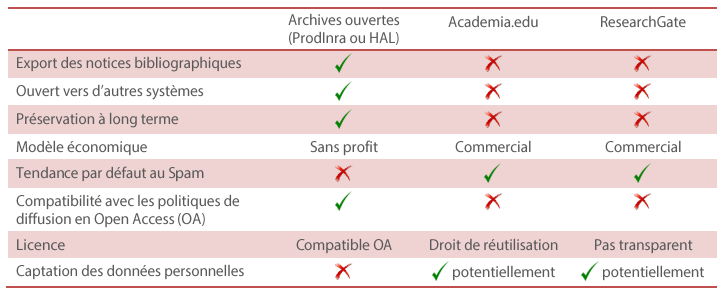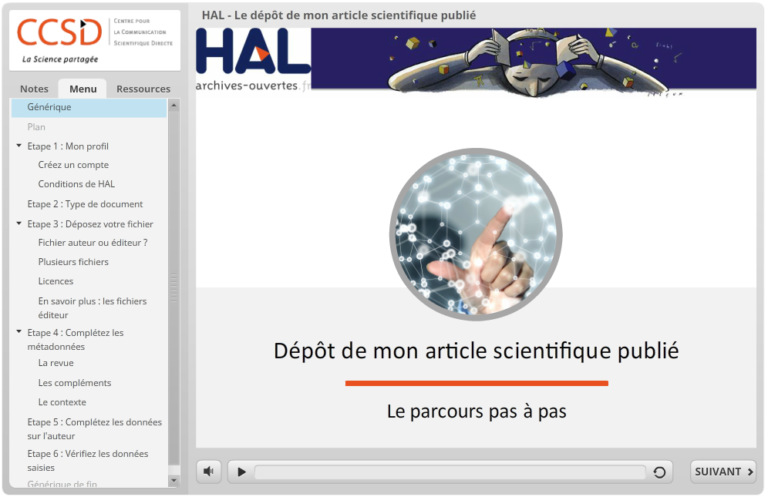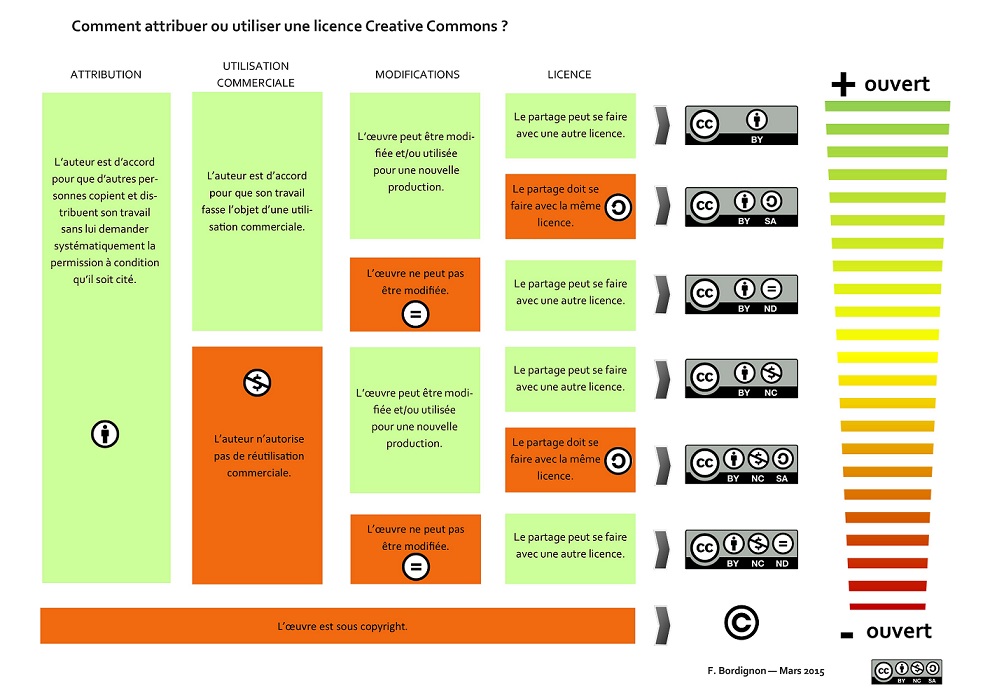Why deposit your documents in HAL ?
To share science and make it more accessible
Publicly-funded research should be accessible to all, not only researchers. Researchers write their articles for no extra pay, do most of the work of final formatting and in addition review the work of their peers, also free of charge. Alongside this unpaid work, documentation departments and libraries have to accommodate to the continuous and very significant increases in the cost of subscriptions, which means they have to make more and more choices and therefore cancel certain subscriptions.
Depositing documents in HAL, or an Open Access publication, is therefore a civic act of sharing.
To increase the visibility of your work
Open archives in general, and of course the HAL repository, are developed to interoperate with other archives and other search engines.
Google Scholar (see our page on Google Scholar) harvests and displays links to the HAL repository.
OpenAire (Open Access Infrastructure for Research in Europe, simultaneously a European Open Access project and a portal), harvests HAL and other French open access archives such as Archimer or OATAO, in the same way as the Isidore platform does for the social sciences and humanities.
When you deposit research in HAL, you can also transfer your deposit automatically to another archive, in order to avoid having to make 2 separate deposits.
HAL allows transfers to arXiv (see the page explaining HAL here) and PubMed (and the other page explaining HAL there (in French)), only if the full text has been deposited.
Finally, Repec harvests HAL and thereby retrieves files that fall within the disciplinary domains of Economics and Finance or Management.
Many studies have been conducted on the visibility of Open Access documents; most of them conclude that Open Access has a positive impact on the citation rate. Moreover, if counting citations is not your thing, in addition to the statistics on downloads and readings of your postings, HAL offers you alternative metrics that identify the use of your output on social networks, scientific exchange platforms, blogs or Wikipedia. This is the Altmetric indicator, which is represented by a donut:

Because ResearchGate and Academia are not Open Access platforms
ResearchGate and Academia are not open archives. They are profit-making enterprises which are certainly useful when you want to contact other researchers, but are in no way a substitute for depositing research in HAL or publishing directly in open access. In any case, these platforms frequently harvest HAL and will quickly find your documents; you will receive an email asking you to confirm that you are the author and the link will be made that way…
In October 2016, INRA published analysis and recommendations on this subject, as well as a table comparing the platforms:

Source : INRA, 2016, Activ’IST n°1
Because HAL guarantees long-term access
Because of its persistent URLs and because of the CINES storage system, HAL guarantees you lasting storage of files and of the link used to access them.
Because depositing a document doesn’t take that much time…
- The Scholarly Communication Unit regularly imports article references into HAL so that all you have to do is add the full text.
- When depositing a PDF, HAL will try to recover as much information as possible to add to the dedicated metadata form, even the names of the authors.
- When inputting the metadata, if you have a DOI, or a PubMed, Arxiv, ADS, ProdInra, or Irstea ID (and there are more!), all you have to do is copy and paste it into the dedicated field and HAL will retrieve as much metadata as possible.
Another way that depositing papers in HAL saves you time is by automatically generating a list of your publications, for example for an activity report or to maintain an updated list on a webpage (access the page settings form here), or in the case of CNRS researchers, your CRAC and RIBAC reports.
We carried out our own study based on data relating to the 31 researchers who have deposited more than a hundred papers as authors in HAL-ENPC. In each case, we identified the 5 years when they deposited the most papers, and we reached an estimate of 15 for the number of deposits made per year. These are the most active researchers, so this is really the upper range, and the average is actually much lower. Moreover, the deposits may have been made by their co-authors (or by librarians). But even with 15 papers deposited per year, at five minutes each, that means spending not much more than two hours a year on this essential research sharing procedure.
How to deposit a paper?
The Scholarly Communication Unit can help you…
… by organizing workshops in your laboratory and answering all your questions.
Contact your referring librarian or open a chat to try to get an immediate answer.
A video tutorial
CCSD (Centre for Direct Scientific Communication), the CNRS unit in charge of HAL, has produced a very comprehensive video tutorial on how to deposit a document in HAL.
HAL documentation
 https://doc.archives-ouvertes.fr/en/homepage/
https://doc.archives-ouvertes.fr/en/homepage/
Which portal?
- If you’re used to depositing papers via HAL-SHS
- if you have already deposited in MADIS (IFSTTAR) or another institutional archives that feeds into HAL (e.g. ProdInra)
- if one of your co-authors has deposited a paper via another portal
that is no problem – there is absolutely no need to deposit multiple times! Portals are different points of entry to HAL, but there is only a single HAL archive.
What version?
The Loi pour une République Numérique (Digital Republic Act) greatly simplifies the situation and allows you to deposit the postprint (the final accepted version) of your articles in HAL with a maximum embargo of 6 months for journals in the scientific, technological and medical fields, or 12 months for social science journals, regardless of the contract signed with the publisher.
 See our dedicated Open Access page for more details
See our dedicated Open Access page for more details
For other kinds of documents and all articles published before the promulgation of the Act on 8 October 2016, you need to refer to what the publishers allow: the preprint, the postprint, or the publisher PDF. For more information, go to the Sherpa/Romeo website, which summarizes the publishers’ Open Access policies and classifies their journals on the basis of a color code:
- Green journals, for which you can deposit the preprint and the postprint, or sometimes even the publisher PDF
- Yellow journals, for which you can deposit the preprint
- Blue journals, for which you can deposit the postprint or the publisher PDF
- White journals, for which you are not allowed to deposit any full-text version.
Where to find the postprint to deposit?
You should already have it! The easiest way is to deposit the postprint as soon as the article has been published, and to apply an embargo that will release it automatically without needing to further think about it. That way you won’t risk to lose the file in the meantime.
Some publishers allow you to retrieve the postprint that was submitted on their platform: see the article "How to retrieve its postprint on a publisher's platform". For Elsevier in particular, you need to follow the steps given by the publisher (page 10: "Finding your accepted author manuscript"). The Université de Lille has also created a mini-tutorial (in French) to explain this procedure.
Finally if you have lost it and your co-authors no longer have it, some publishers allow the publisher PDF to be deposited after a delay that you can find on the Sherpa/Romeo website, in this case simply download the PDF on their portal (or ask your librarian if we have no subscription to it).
How to apply an embargo?
Throughout the whole period of the embargo, the publisher retains the exclusive right of distribution, but fortunately HAL has, since the beginning of 2016, nevertheless offered the possibility of accessing embargoed documents using the “request button”.
If Alice has placed an embargo on her document (whether by obligation or personal choice), Bob – after going through the HAL authentication process – can ask her for access to it. Either Alice refuses, and the article remains enclosed in the HAL archive, or she accepts and Bob can access the document in his HAL account, in the section My space/My shared embargoed documents.

Clearly, this means that there are no longer any obstacles to depositing papers in HAL and in sharing research results. The embargo can be applied once the file has been uploaded to HAL, in the detailed view, and by clicking on a discreet little pencil icon on the right hand side of the screen opposite the file name, in the Actions column. The length of the embargo is set using the Visibility drop-down menu.

What license?
HAL allows (but does not oblige) you to attach a Creative Commons license to your paper, i.e. an addition to copyright which enables authors to say what they allow or prohibit for the document they are depositing.
There are 6 Creative Commons licenses built around 4 options (click on the image to enlarge):





